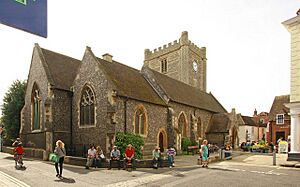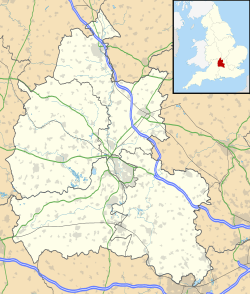St Mary-le-More, Wallingford facts for kids
Quick facts for kids Church of St Mary-le-More |
|
|---|---|
 |
|
| 51°35′59″N 1°07′30″W / 51.5996°N 1.1249°W | |
| Location | Wallingford, Oxfordshire, England |
| Denomination | Church of England |
| Architecture | |
| Heritage designation | Grade 2 listed |
| Architectural type | Church |
| Style | Gothic revival |
| Administration | |
| Archdeaconry | Dorchester on Thames |
| Diocese | Oxford |
| Province | Canterbury |
St Mary-le-More is a Church of England parish church located in Wallingford, Oxfordshire, England. You can find this church right in the middle of The Marketplace, just behind the Town Hall. It's a historic building that has been an important part of the community for many centuries.
Contents
History of St Mary-le-More Church
Early Beginnings and Rebuilding
The Church of St Mary-le-More has been around since at least 1077. Back then, it was connected to St Alban's Abbey. The church's tall tower on the west side was first built in the 1100s. Later, around 1653, the top parts of the tower were rebuilt in a style called Perpendicular Gothic. This style is known for its tall, straight lines and large windows.
The main part of the church, called the nave, and the side paths, known as aisles, were built in the 1200s and 1300s. The area around the altar, called the chancel, was added a bit later. However, all these parts were rebuilt in 1854. This work was done by David Brandon, an architect who specialized in the Gothic Revival style. This style brought back the look of medieval churches.
Inside the Church: Art and Features
Inside the church, you can see some beautiful features. The west window in the north aisle has stained glass that was made in 1856 by Thomas Willement. The pulpit, which is where sermons are given, was created in 1888 by the sculptor Onslow Ford. St Mary-le-More is recognized as a Grade II* listed building. This means it's a very important historic building.
Modern Updates and Accessibility
Between 2009 and 2010, the church was updated to make it more comfortable and welcoming. New heating was put under the floor, and the floor was retiled. They also added two restrooms, including one that is accessible for people with disabilities and has baby changing facilities.
A kitchen with a black marble top was installed in the north aisle. It has a sink, fridge, and dishwasher. To make the church easier for everyone to use, ramps and level flooring were added. This allows wheelchair access to most areas. An audio-visual system with a hearing loop was also installed. This system is used for services, concerts, and other events held at the church.
Changes to Worship Areas
The Lady Chapel, a special area for prayer, was moved during the updates. It is now located near the main altar. This new Lady Chapel is a quiet space for visitors and for people attending services.
The main altar, used for Holy Communion services, is now in the center of the nave, in front of the Rood Screen. This altar can be moved if the space is needed for concerts or other events.
A meeting room was created above the clergy vestry inside the church tower. You can reach this room by a new staircase and a mezzanine floor. There's also extra storage space for chairs and other items.
Most of the old wooden pews were replaced with lighter, stackable chairs. However, some pews were kept for the Mayor of Wallingford and the Town Council to use during special civic services. These pews are now along the walls of the nave and north aisle. New oak chairs, in the traditional Gothic Revival style, were bought for the Lady Chapel.
Since 2009–2010, more items have been added to the church. One special item is a wall banner next to the Rood Screen. These banners show the different seasons of the liturgical year (the church calendar). Members of the church made these banners between 2017 and 2019.
Church Bells
The Ring of 10 Bells
The tower of St Mary-le-More has a set of 10 bells that are used for Change ringing. This is a special way of ringing bells in a changing pattern.
Originally, a set of eight bells, including the largest one called the tenor, was made in 1738. These bells were cast by Richard Phelps and Thomas Lester at the Whitechapel Bell Foundry. This foundry is famous for making bells.
In 1887, the year of Queen Victoria's Golden Jubilee, one of the bells was recast by Mears and Stainbank, also from the Whitechapel Bell Foundry. Then, in 2003, the Whitechapel Bell Foundry made two new bells. These new bells, called the treble and second bell, increased the total number of bells to 10.


